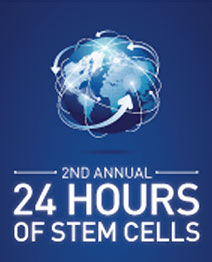
The Second Annual 24 Hours of Stem Cells Virtual Conference Begins Today
Today Life Technologies is presenting their second annual 24 Hours of Stem Cells, an innovative approach to the virtual conference. After logging in, you are brought into a virtual conference hall with several options to explore, including an Exhibit Hall, Resource Center, Live Chat area and the Auditorium. In the Auditorium you can choose between viewing live sessions with live Q and A opportunities with the presenters or on-demand presentations with there are Q and A opportunities available by email.
So far I have attended three presentations and I have outlined a bit from each presentation below:
Development of Chemically Defined Cell Culture for Human Pluripotent Stem Cells by Guokai Chen, Ph.D., Associate Professor, Faculty of Health Sciences, University of Macau, China
Dr. Chen presented a very interesting talk on his group’s (Guokai Chen et al.) development of Essential 8 Medium for human pluripotent stem cells in James Thomson’s laboratory. He begins by discussing the motivation for looking at developing a chemically defined medium including some of the challenges associated with using undefined media components in cell culture when moving to a clinical setting. These challenges include additional regulations and testing requirements and reagent inconsistencies.
Dr. Chen then reviewed the steps that they took when developing the medium. One of the key steps was to screen to see which components were essential this included insulin, vitamin C, TGF/nodal, FGF2, selenium and transferrin. Thus forming the basis for the Essential 8 medium, which also includes DMEM-F12 and NaHCO3. Dr. Chen then discusses his work in developing defined surface coating based on Essential 8 medium, developing new stem cell handling methods, and clinically suitable differentiation methods that are being developed for high demand cell types. It was an excellent talk and I highly recommend it.
Scalable Production of Human Stem/Progenitor Cells in Bioreactor Systems by Cláudia Lobato da Silva, Ph.D., Stem Cell Bioengineering and Regenerative Medicine Laboratory, Instituto Superior Técnico, Universidade de Lisboa, Portugal
Dr. Cláudia Lobato da Silva presented a very interesting series of case studies in which her lab worked to combine bioprocess engineering with cellular systems biology to meet the high cell demand of Cell Therapy manufacturing. The aim was to produce several millions of cells in a safe, cost effective method.
She then discusses her lab’s success in culturing mesenchymal and stromal cells in a stirred tank bioreactor. To achieve this they used a combination of plastic microcarriers, spinner flasks and stirred tank bioreactors and were able to scale up under xeno-free conditions to 1 liter bioreactors. Her group then tried using perfusion culture and by employing perfusion was able to obtain clinically relevant cell numbers within 7- 10 days.
Dr. Cláudia Lobato da Silva then discusses another example of her work, this time using umbilical cord blood cells. Her team created a co-culture system combining hematopoietic stem cells with mesenchymal cells. By using a combination of spinner flasks and microcarriers, her group was able to achieve serum-free co-culture. This was another fantastic presentation for anyone interested in learning about using bioprocess engineering approaches in Cell Therapy manufacturing.
Reversibility of the Cellular Aging Physiology through an iPSC State: A New Paradigm for Human Cell Rejuvenation, Jean-Marc Lemaitre, Ph.D., Deputy Director of the Institute of Regenerative Medicine and Biotherapies, Saint Eloi Hospital, CHRU Montpellier, France
Dr. Lemaitre provided a very interesting look at senescent cells and the ability to reprogram these cells to pluripotency. His group asked the question whether these cells could be reprogrammed from aged donors to iPSCs and if so, could you erase the senescence. After attempting to reprogram using Oct4, Sox2, Klf4, and c-Myc without success and Oct4, Sox2, Nanog, Lin28 without success they discovered that they could use a 6 factor strategy of Oct4, Sox2, Klf4, c-Myc, Nanog, and Lin28 successfully. As a result they were able to generate iPSCs from centenarians with the all the properties of pluripotency.
Dr. Lemaitre walked through all the process steps in detail, but the take away as stated in his summary was that by reprogramming through the pluripotent state they were able to erase the hallmarks of cellular aging and create a new paradigm for cell rejuvenation. He went on to point out that iPSCs could be generated from aged patients for use in Cell Therapy and from patients with premature aging syndromes to create human development models and also to enable drug screening.
Overall I think the Life Technologies 24 hours of stem cells is a very interesting and easy to navigate virtual stem cell conference. I find that it is an innovative way to share information, is completely on demand, and requires no travel or coordination for time zones.
You can see the program and register for 24 hours of stem cells here – Program